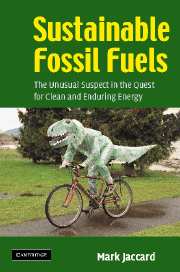Book contents
- Frontmatter
- Contents
- List of figures
- List of tables
- Preface
- Acknowledgments
- 1 What is energy sustainability?
- 2 Is our current energy path sustainable?
- 3 The prospects for clean secondary energy
- 4 The usual suspects: efficiency, nuclear and renewables
- 5 The unusual suspect: how long can fossil fuels last – and does it matter?
- 6 Can we use fossil fuels cleanly – and what might it cost?
- 7 Sustainable energy choices: comparing the options
- 8 Sustainable energy policy: how do we get there?
- 9 Broadening the definition: is sustainable energy sustainable?
- Bibliography
- Appendix ‒ synopsis and chapter reading guide
- Index
2 - Is our current energy path sustainable?
Published online by Cambridge University Press: 06 July 2010
- Frontmatter
- Contents
- List of figures
- List of tables
- Preface
- Acknowledgments
- 1 What is energy sustainability?
- 2 Is our current energy path sustainable?
- 3 The prospects for clean secondary energy
- 4 The usual suspects: efficiency, nuclear and renewables
- 5 The unusual suspect: how long can fossil fuels last – and does it matter?
- 6 Can we use fossil fuels cleanly – and what might it cost?
- 7 Sustainable energy choices: comparing the options
- 8 Sustainable energy policy: how do we get there?
- 9 Broadening the definition: is sustainable energy sustainable?
- Bibliography
- Appendix ‒ synopsis and chapter reading guide
- Index
Summary
The art and science of energy system forecasting
To determine if our energy system is sustainable, we need to estimate where it is headed. Although the system currently works – which some might debate – this is no guarantee that it is not on the verge of exhaustion of a critical input or a catastrophic environmental collapse. To decide how, if at all, we should act upon our energy system today, we must decide if we are happy with where it is headed over the longer term. This means that we have to forecast the energy system's likely evolution in the absence of efforts to change course.
However, as one wag said, “forecasting is difficult – especially into the future.” Indeed, exercises in forecasting and prediction are now recognized as so imbued with uncertainty and with the biases of forecasters that it has become fashionable for some energy analysts to pronounce their opposition to forecasting altogether. Certainly, it is true that hindsight analysis in recent years has revealed the abysmal predictive record of most energy forecasting exercises. But does this mean that we should just throw up our hands and avoid forecasting?
Unfortunately, avoidance is not an option. Politicians, businesses and individuals are always making decisions that shape our future and these decisions are made with some implicit notion of how the world is likely to unfold. That implicit notion is a forecast. In the same vein, policy makers cannot abstain from making policy in areas where they have responsibility.
- Type
- Chapter
- Information
- Sustainable Fossil FuelsThe Unusual Suspect in the Quest for Clean and Enduring Energy, pp. 31 - 55Publisher: Cambridge University PressPrint publication year: 2006



